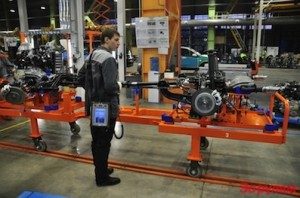The rules governing subsidies for the domestic movement of vehicle volumes in Russia are to be changed following a decree recently signed by the country’s Prime Minister, Dmitry Medvedev, with an increase in the overall amount of support offered by federal and regional governments.

Russia already subsidises the cost of moving cars from the Far East to the region known as the Central Federal District. The new decree extends this to take in the South Federal District, including the ports of Novorossiysk and Sochi, as well as the North Western Federal District, including the ports of St Petersburg and Ust-Luga.
According to official information, the government will spend RUB 3 billion ($50m) on this extension of the subsidy, with the majority going to benefit Russian car manufacturer Sollers, which has assembly contracts in the Far East for the production of SsangYong, Mazda and Toyota models. Toyota, however, has recently announced that it would end manufacturing of its Prado SUV at the plant.
The new subsidy appears to reverse an earlier decision to limit the logistics subsidy for the automotive industry. Earlier this summer Denis Manturov, the minister for Trade and Industry, said that the government would not increase the size offederal subsidies on car transport, which were initially expected to be RUB 3.2 billion this year. He went on to says that the government could demand that regional budgets allocate subsidies, including for the movement of vehicle volumes within the internal market. There was also discussion earlier this summer about the potential to extend logistics subsidies to ocean transport from Vladisvostock to western markets.
According to sources, the proposed ocean transport subsidy had been resisted by Russian Railways, which would have stood to lose business from the movement of around 50,000 vehicles per year to western Russia. The subsidy was thought in particular to have been resisted by Vladimir Yakunin, who left his post as head of the Russian Railways in late August to take up a role as a senator.
According to sources, the subsidy to central and southern regions, on the other hand, is expected to represent both an increase in federal spending, which is also likely to be topped up by regional governments.
The new subsidy is another effort to support Russia's weakening automotive manufacturing base, particularly those low-volume plants in the Far East that struggle to compete with either western Russian plants or those in Asia. Toyota, for example, will shift Prado production back to Japan.
Some analysts and logistics executives suggest that the subsidy could be a way to further boost exports from such plants as well, since they will reduce the logistics costs for Russian-built vehicles compared to some European supply chain routes.
“The costs of ground shipping cars to the port of embarkation for vessels in St Petersburg and Ust-Luga will not be significant,” said Dmitry Vostrikov, general manager of Wallenius Wilhelmsen Logistics. “In this regard, the Russian producers even have an advantage in comparison with European, especially German, brands, for which the cost of transportation from the factory to the port is a significant share of total logistics costs.
“For shippers, moving cars from St. Petersburg will be an added advantage because now the volume of export of goods from Russia and St Petersburg in particular, is extremely small," added Vostrikov. "The cost of sea transport from St Petersburg will depend on the location of the final port of discharge. But in any case sea freight rates will not differ significantly from the existing tariffs for shipping services in Europe.”
However, the prospect of shipping Russian-built vehicles in the Far East to European or other neighbouring markest west of Russia may not make much economic sense. According to logistics experts, however, Russia’s best opportunities for exporting vehicles remain via the Baltic Sea rather than the Far East.
“The most advanced and promising [export] routes lie through the Baltic Sea ports with transhipment in European ports, such as Antwerp and Bremerhaven, or in the ports of Scandinavian countries,” said Sergey Bobryshev, logistic director of Glovis Rus, which moves Hyundai and Kia volumes in Russia. “With such mass transport, the most effective routes are those that have minimal time and cost impact on the inland transport side, and that is what most manufacturers are looking for.”
Representatives of Sollers have not yet commented on the possibility of exporting from the company’s Far Eastern production units. Sources at the company stated that it could see some benefit from regional sales inside Russia as the north-west and south federal districts are significant in themselves. Exports could be explored at a later date, when the prospects for the domestic market become clearer.
While carmakers in Russia including Avtovaz, GAZ, Hyundai Motors, Nissan and Volkswagen have all expressed interest in exporting vehicle from Russia, the country's vehicle exports in the first half of 2015 were down 27% compared to the same period last year, at 48,900 vehicles.

























![Global[1]](https://d3n5uof8vony13.cloudfront.net/Pictures/web/a/d/s/global1_726550.svgz)









